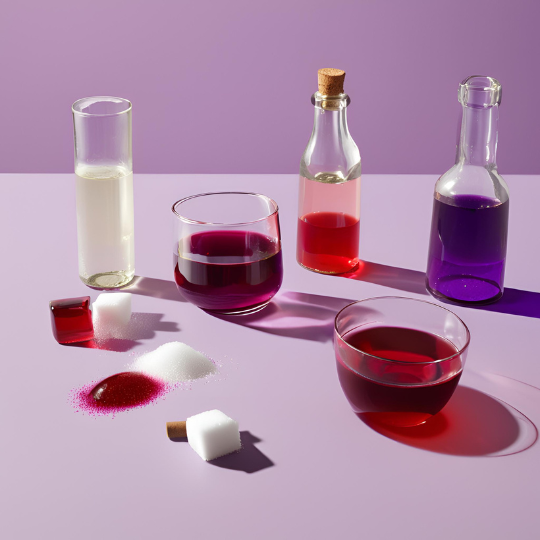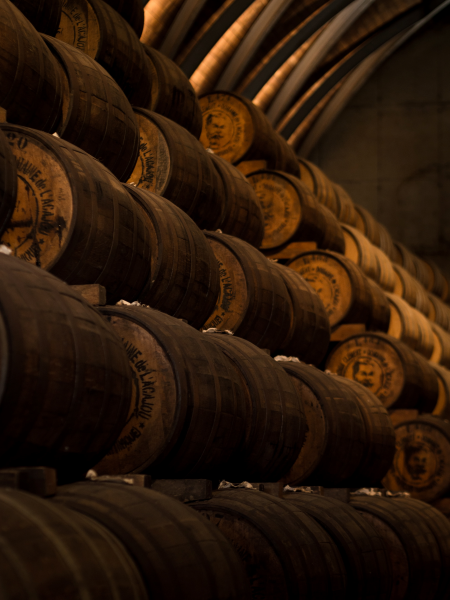Have you ever wondered how color and flavor additives in wine affect what’s really in your glass?
It’s tempting to think that wine flavors and colors are pure products of nature and the vineyard. However, in reality, large-scale wine producers often rely on additives. They use these to create consistency, enhance flavors, and perfect the appearance of each bottle. Unfortunately, additives aren’t just harmless enhancements; they can introduce sugars, chemicals, and compounds that affect health. So, let’s learn more about the Truth About Wine Additives and Preservatives. Here’s a closer look at how the most common color and flavor additives impact health and taste.
Color Additives in Wine: From Ruby Red to Deep Purple
When we picture wine, it’s often a rich, ruby red or a dark purple hue. However, in large-scale production, these colors don’t always come straight from the grape. Wine colors are often enhanced with colorants, which ensure each bottle looks appealing and consistent. While safe for consumption in regulated amounts, colorants come with health implications. They might also change your perception of what’s really in your glass.
Mega Purple: The Sweet, Deep Hue
Mega Purple is a widely used grape concentrate derived from Rubired grapes. This syrup darkens a wine’s color dramatically with only a tiny amount. However, it also adds sweetness. Mega Purple smooths out inconsistencies and creates uniform taste in wines that may lack complexity or character. However, it also adds sugar, which can spike blood sugar levels. When combined with alcohol, this can lead to harsher hangovers.
Health Impact: Though grape-derived, Mega Purple’s sugar can be an issue for people managing caloric or sugar intake. Over time, sugar-heavy wines can contribute to weight gain, metabolic issues, and insulin spikes.
Ultra Red and Other Additives in Wine: Visual Appeal at a Cost?
Ultra Red, another popular color enhancer, is known for its intense staining properties. While it may create a striking wine color, it can also leave residues on teeth. It may even mask the wine’s true flavor. With Ultra Red, wines can taste almost the same bottle to bottle, which many drinkers feel lessens the experience.
Health Impact: Like Mega Purple, Ultra Red can add sugars that contribute to tooth decay and blood sugar spikes. These additives may detract from the wine’s natural essence and character.
Anthocyanins: The Natural, Yet Overused Additive in Wine
Anthocyanins, naturally occurring in grape skins, give red wines their vibrant color. While these compounds are safe and contain antioxidants, they’re often extracted and concentrated for intense color. This can cover up a wine’s unique flavor profile, creating a more generic taste across wines.
Health Impact: Overuse of anthocyanins doesn’t pose significant health risks. However, for those with sensitivities, heavy concentration can sometimes cause mild allergic reactions or digestive issues. Lack of label transparency means drinkers may not know when these concentrates have been added.
Flavor Additives in Wine: Enhancing Taste at a Cost
Flavoring agents are also used in mass wine production to standardize taste and create a reliable product year-round. From oak flavoring to artificial sweeteners, these enhancers can make a wine more accessible to the general palate but can also have some less desirable health effects. If you want to learn more about the Health Risks of Wine Additives you can go here.
Oak Flavoring Additives: Simulating Barrel Aging
To avoid the expense of traditional barrel-aging, some winemakers add oak chips, staves, or extracts. These create familiar notes of vanilla, caramel, and spices in wine. While these flavor enhancers make wines taste smooth and complex, they lack the nuanced depth from actual aging in oak barrels.
Health Impact: Oak flavoring isn’t necessarily harmful but can make wine taste synthetic. For those sensitive to artificial flavors, this can result in mild headaches or digestive issues. Authentic oak barrel-aged wines may cost more, but they offer a natural depth that synthetic flavors can’t replicate.
Artificial Sweeteners: Sweet Taste, Lingering Health Risks
Some wines use sweeteners—natural ones like added grape juice or artificial ones like high-fructose corn syrup or even sucralose. These sweeteners increase sweetness without changing calorie count. Although sweeteners may attract more consumers, artificial options can cause side effects in sensitive individuals.
Health Impact: Artificial sweeteners may disrupt digestive health, causing bloating, gas, or headaches. They can also impact blood sugar levels unpredictably when consumed with alcohol. For those wanting to avoid additives, opting for wines without added sweeteners can help avoid these potential issues.
Acid Blends: The Chemistry of Balance
Natural acidity in grapes usually includes tartaric, malic, and citric acids, which give wines their signature tang. To balance inconsistencies, some producers add acid blends to regulate the wine’s pH, giving it a bright “fresh” flavor even when the grapes weren’t perfect.
Health Impact: While safe, acidifiers can sometimes create a synthetic taste that some find unpleasant. Individuals with acid reflux or sensitive stomachs may find this extra acidity exacerbates discomfort, causing digestive distress.
Dimethyl Dicarbonate (DMDC): A Powerful Preservative
DMDC is a chemical preservative added just before bottling. It prevents microbial growth and keeps wine stable on store shelves. While DMDC breaks down into harmless components, it’s a potent chemical that can make wine less appealing to some drinkers.
Health Impact: Though safe after breaking down, DMDC can still provoke digestive upsets and mild headaches in people sensitive to preservatives. Health-conscious drinkers might prefer wines that avoid this treatment, even at a higher price point.
Lack of Label Transparency: Hidden Additives in Wine
In the United States, wine labels aren’t required to list ingredients as food labels do. This lack of transparency means that drinkers have no idea what color and flavor additives are used. People with sensitivities to sugars, sulfites, or artificial flavorings might unknowingly consume compounds that can lead to headaches, digestive issues, or allergic reactions. When choosing wine, consumers lack a clear understanding of what they’re drinking.
Finding Additive-Free Wines
For those seeking a more natural wine experience, organic, biodynamic, or natural wines are excellent options. These wines are crafted with minimal intervention and avoid color and flavor additives, letting the grape’s true character shine. Smaller vineyards and artisanal producers are also more likely to prioritize authenticity, creating an unadulterated wine experience.
Conclusion: Wine with Awareness
Exploring hidden color and flavor additives in mass-market wines helps us understand what’s in each glass. Additives like Mega Purple, Ultra Red, and flavor enhancers create appealing products, but they can also mask a wine’s true taste. They introduce sugars and preservatives that impact health. For those who value authenticity and a cleaner drinking experience, wines with fewer additives offer a more genuine connection to the vineyard. Cheers to enjoying wine with a touch of knowledge!
Now that you know the Truth About Wine Additives and Preservatives, you’re set to make smarter, tastier, and healthier choices. Want to explore the world of fine wines? Having the right information makes all the difference.
For more tips and insights, check out a few other pages:
- Magic of Wine – Uncover wine’s incredible versatility, from pairing tips to relaxation benefits.
- Explore Fine Wines Delivered to Your Door – Dive into an exquisite collection of high-quality wines that elevate any occasion.
- Exclusive Napa Sonoma Wines – Get insider access to truly exceptional wines from legendary Napa and Sonoma vineyards.
Want to stay in the loop? Join our FREE email list at Tami’s Terrific Treasures to get insider tips, exclusive finds, and first dibs on treasures you won’t want to miss.
Have questions about our wine or any of our other offers? I’d love to help! Just click here to reach out anytime.




